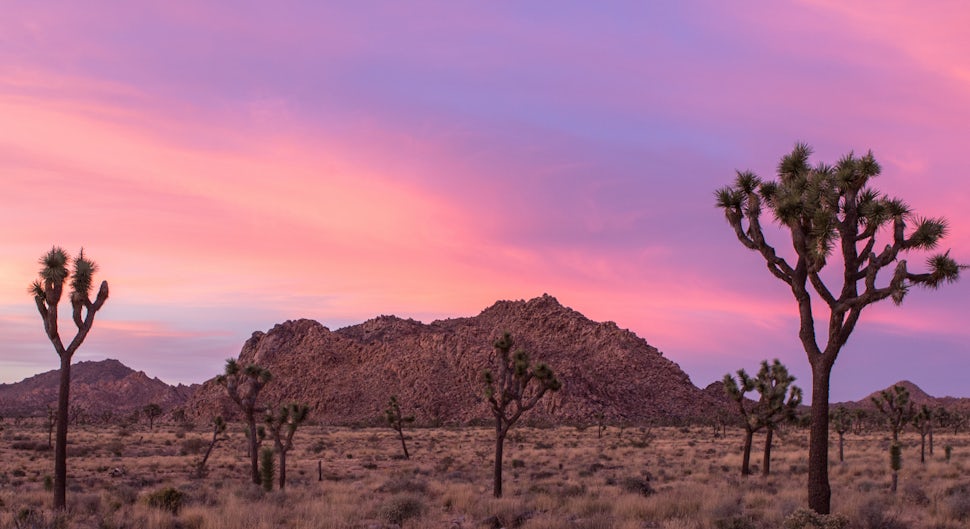5 Things to Know Before Adventuring in Joshua Tree National Park
Joshua Tree is an incredible national park to explore for climbing, camping, hiking and photography. However, there are a few important things to know before you go. These will make a difference in whether you have an incredible and safe experience or a difficult one.

Joshua Tree is one of our all-time favorite national parks. It took me awhile to come to love desert parks in general, but the beauty, unique setting, incredible sunrises and sunsets, along with its world-class climbing changed my mind. We are a rock climbing family and travel each November from Boulder, Colorado for a week to climb and photograph the park. There are a few important things we learned a few years ago about JTNP that I think are helpful to pass along. Here are a five things that will help you prepare for your trip to Joshua Tree. If you need information on climbing and hiking in the park, a great place to stop on your way into the park is Nomad Ventures. They have all kinds of awesome gear and knowledge to help you.
1. There is no water in the park. None. You need to plan ahead whether doing a day trip or camping for several days and bring all your own water. Temperatures vary depending on season but summer is crazy hot (around high 90s to 100 degrees on average) and the shoulder seasons can have hot days as well. Plan ahead and take more water than you think you might need. To follow up on that point, there is no food either - no amenities other than pit toilets, so bring your own everything.
2. Know where you are going. It is easier to get lost in this park than you would think. There are not many signs for certain trails or climbing locations. A lot of times you are going off of a climbing guide or hiking book and the descriptions are not detailed enough. Although we have never gotten lost, the area of Wonderland provided some challenges through the maze of rock formations that all tower above. Be aware of your surroundings and direction when you head off of the main trails. Also, there is no cell service in most of the park so it is a good idea to tell someone where you are climbing or hiking before you set out.
3. Wear closed-toe shoes. Living in Boulder County, we often wear Chacos to easily cross streams and rivers when approaching climbing areas or on easy hikes. Loving my Chacos and flip-flops, I have worn them in Joshua Tree at times and still do if we are climbing near the car or campground. However, I have also ended up with something sharp in my foot. Now one could claim that is because I am somewhat clumsy and I'll give you that, but I am not the only person this happens to. Hang out at Cholla Gardens for any amount of time and you will run into someone who has had a run-in with cactus. Cholla are also known as "jumping cactus" because if one spike gets your skin, the cactus bulb detaches from the plant and attaches to you. My son experienced this once and had to pull about 50 barbed needles out of his ankle. There are other types of cactus in the park that you can step on that will poke all the way through your shoe or spikey plants you walk right by (watch your legs for that too). Add in the possibility of scorpions, tarantulas and snakes on trails if you need more convincing, but let's not get distracted because this park is so worth it. La Sportiva is my favorite brand for climbing shoes, approach shoes and trail shoes. Just a suggestion in case you need shoes.
4. Tread lightly on the desert. This is a fairly fragile ecosystem with delicate plants and endangered animals. The threatened Mojave Desert Tortoise resides here and some are killed each year by cars. Drive carefully, especially at night as these tortoises use the roads. Also, take care while hiking, climbing and taking photos. Cryptobiotic Crusts (a living type of crust on the land) covers some of the park. These are fragile so try not to step on these areas. Read more about this and what it looks like on Joshua Tree National Park's website here. With more and more visitors to our parks each year, we need to all do our part to leave no trace and protect the fragile ecosystems and environments we visit.
5. Layer your clothing for all seasons - Even though this is the desert, it gets cold. It even snows here occasionally in winter (not much - but it is pretty awesome when it does). Nights can be much colder in the high desert too. We have found fall to be pretty cold with the wind on some days. Also, you definitely want to come early or leave late to enjoy a sunrise or sunset. They can be incredible in the desert. So worth it.
Have a blast. It is an incredible park and very unique. Hit me up if you have any questions or want more information.
We want to acknowledge and thank the past, present, and future generations of all Native Nations and Indigenous Peoples whose ancestral lands we travel, explore, and play on. Always practice Leave No Trace ethics on your adventures and follow local regulations. Please explore responsibly!
Do you love the outdoors?
Yep, us too. That's why we send you the best local adventures, stories, and expert advice, right to your inbox.











